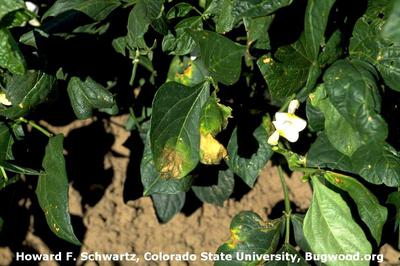Bacterial Leaf Blight of Bean
Xanthomonas axonopodis pv. phaseoli
Bacteria
In a Nutshell
- Small, water-soaked spots with lemon-yellow margins on the leaves.
- Spots grow into dry, brown and necrotic lesions.
- Plants can defoliate.
- Stunted growth.
- Reddish streaks on stems, when split releasing a yellowish exudate.
Can also be found in
Symptoms
The infection can occur at any growth stage. The symptoms differ slightly depending on the plant age. Seedlings with injured growing tips and angular water-soaked spots on primary leaves and stems develop from infected seeds. The plants show a characteristic wilt during the day. If the infection occurs during later growth stages, the leaves show small, water-soaked spots with lemon-yellow margins. Over time, they grow into brown, necrotic lesions that give the plant a burnt appearance. This might result in defoliation. Infected plants remain dwarf and produce few pods with reddish-brown or brick-red lesions. The stem develops reddish streaks. It often splits and releases a yellowish exudate. If the infection occurs during pod development, the seeds may appear shriveled, shrunken, rotten or discolored.
Recommendations

Organic Control
Sorry, we don't know of any alternative treatment against Xanthomonas axonopodis pv. phaseoli. Please get in touch with us in case you know of something that might help to fight this disease. Looking forward hearing from you.

Chemical Control
Always consider an integrated approach with preventive measures together with biological treatments if available. Chemical treatment of the disease is often not viable because the bacteria may develop resistance in the long term. Seeds can be soaked in 500 ppm Streptocycline solution for 30 minutes before sowing. If bactericides are needed, products containing copper oxychloride and an authorized antibiotic (2 g/l of Streptomycine or Plantomycine) can be used as foliar treatments.
What caused it?
The bacteria Xanthomonas axonopodis pv. phaseoli remain dormant for several years in the soil, seed coat, alternative hosts and on plant debris. Rainy, wet and warm weather conditions (25-35°C) and humidity favor the occurrence. The disease is heavily spread through wind driven rain, rain splashes and insects (grasshoppers and bean beetles). Natural openings and wounds on plants also favor the occurrence.
Preventive Measures
- Use certified, pathogen-free seed material.
- Plant resilient tolerant or resistant varieties.
- Check your plants or fields for signs of disease.
- Ensure suitable planting time in the area.
- Avoid sprinkler irrigation.
- Keep your equipment and tools clean.
- Remove or destroy infected plants by burning them.
- Crop rotation with non-host crops (maize) is recommended for the given period.



